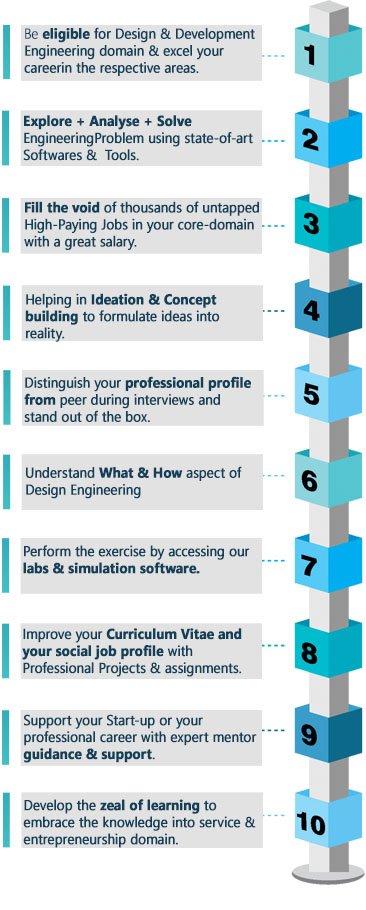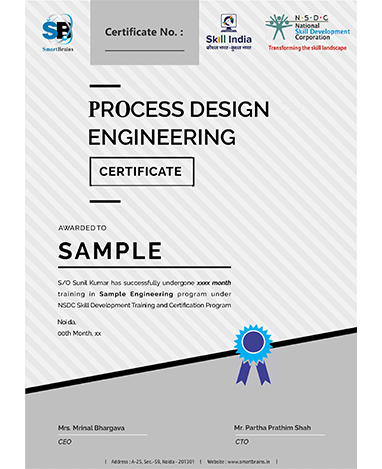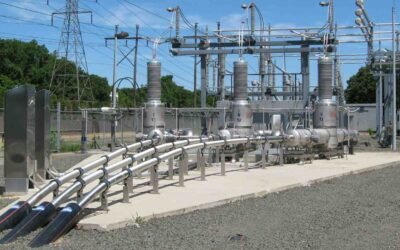About the Program
The objective of this PG Diploma course is to provide the candidates the Detail knowledge and skills in Embedded System Design Engineering discipline to facilitate faster learning curves while on the job.
This course on Embedded systems will first the students to the fundamental requirements of embedded systems and the interaction between hardware and software in such systems. Next, the course will discuss some basic steps of hardware design, introduce the students to various microcontrollers. Next, the students will be exposed to the very important issue of designing for less power consumption and introduce them to the techniques that are adapted to this end. Since many of the embedded systems will have real-time constraints, basic issues of real-time operating systems will be discussed. This will be followed by formal specification models and languages, mapping the specification to hardware and software components along with decisions on design tradeoffs and hardware-software partitioning. The course will end with a brief overview of design verification methods that are adapted for embedded system design.
Learning objective
- Discuss the major components that constitute an embedded system.
- Implement small programs to solve well-defined problems on an embedded platform.
- Develop familiarity with tools used to develop in an embedded environment
- Understand what is a microcontroller, microcomputer, embedded system.
- Understand different components of a micro-controller and their interactions.
- Become familiar with the programming environment used to develop embedded systems
- Understand key concepts of embedded systems like IO, timers, interrupts, interaction with peripheral devices
- Learn debugging techniques for an embedded system
Program Highlights

About The Course

Course Modules
- Introduction to Embedded Systems
- What is Embedded System?
- Standard component of Embedded Systems – Processor, Memory, I/O, Peripherals, Software, Algorithms
- Processor types – Microcontrollers, Microprocessors, DSP, FPGA
- Memory types – RAM, SRAM, DRAM, DDRAM, EPROM, EEPROM, OTP
- Peripherals – Parallel and Serial Ports, UART, Timers, Real time clocks, I2C bus, DMA controllers
- Analogue Interfaces – A-D and D-A conversion, CODECs
- Interrupts and Interrupt handling
- Sensor
- Actuators
- Relays
- Foundations of C programming
- Types, declarations, and expressions
- Control Flow, Functions and program structure
- Arrays, pointers, structures
- Input and output handling
- Dynamic Memory Management
- Linked Lists
- Command-line argument handling
- Stacks and queues
- Program Design
- 8051 Architecture and C51 Assembly Language Programming
- 8051 Architecture – Oscillator, Clock, Internal memory and RAM, SFRs, Internal ROM, I/O pins and ports
- External memory, Counters and Timers, Serial Data I/O, Interrupts
- Assembly language instructions
- Data operations, logical operations, arithmetic operations, Program control
- Configuration and programming of 8051 Ports, Timers and Interrupts
- Interfacing 8051 with LEDs, Keypad and 7-Segment Display and programming
- Interfacing with LCD and programming
- Interfacing with ADC and programming
- Serial Data Communication programming
- Embedded C
- Embedded Software development using C
- Porting 8051 Assembly code to C
- AVR Microcontroller
- Pin configuration and architecture.
- Device features.
- Concept of registers and ports
- Programming AVR & Practical Learning
- Introduction to AVR Studio.
- Introduction to Program burning software.
- Starting with Embedded C.
- Generating a different LED pattern
- Rotation of LEDs
- Relay Race of LEDs.
- Binary Counter.
- Inputs to the Controller
- Controlling LEDs with keys.
- Keys as a toggle switch.
- Interfacing a Piezo Buzzer
- Using a buzzer as an alarm unit.
- Interfacing DC motors to AVR
- H-Bridge Circuit
- Working of L293D
- Making of power supply and a basic robotic car.
- PIC Microcontroller
- Introduction to PIC family
- Hardware Details
- PIC Architecture
-
- Pin Diagram
- SFR
- Port I/O configuration
- Interrupts & Timers
- MPLABIDE MPASM
- USART
- System Design using ARM Microcontrollers
- The Arm Cortex-M4 Processor Architecture: Part 1
- The Arm Cortex-M4 Processor Architecture: Part 2
- Introduction to Timers and interface with ARM/Cortex microcontroller
- Introduction to Interrupts and interface with ARM/Cortex microcontroller
- Introduction to Serial Port and interface with ARM/Cortex microcontroller
- Introduction to external peripherals
- Interfacing ARM/Cortex microcontroller with LCD
- Interfacing ARM/Cortex microcontroller with keyboard
- Interfacing ARM/Cortex microcontroller with stepper motor
- System Design using Digital Signal Processors:-Embedded Linux
- Introduction to embedded Linux
- C libraries. Building a cross-compiling toolchain
- Focus on U-boot.
- Configuring, (cross)compiling and booting a Linux kernel
- Creating a simple, BusyBox based root filesystem from scratch
- Block filesystems
- Flash storage and filesystems
- Cross-compiling libraries and applications
- Embedded system building tools
- Lightweight tools for embedded systems. Graphical toolkits
- Developing and debugging applications for the embedded system
- Embedded RTOS
- Embedded Linux Hardware
- Linux Kernel Introduction
- Embedded Linux Development Environment
- Development Tools
- Boot Loader and Tool Chain
- Porting
- GUI Application Development
- RTOS
- Task
- Scheduling
- Task Functions
- System Design Using FPGAs
- Logic block and routing architecture
- Design methodology
- Special resources
- Xilinx Spartan-6
- Altera and Actel FPGAs
- Programming FPGA
- Constraints
- STA
- Timing closure
- Embedded Product Design
- Board layout considerations, signal integrity (noise, crosstalk, etc.), decoupling, techniques.
- Manufacturing and test engineering, PCB design, ground and power planes, EMI, EMC.
- Datasheets, power supplies, voltage regulators. Thermal considerations, heat sinks.
- Oscillators and reset circuits. Microprocessor supervisory circuits, watchdog timers.
- Development and debugging strategies and techniques. Logic probes, voltmeters, and oscilloscopes
Course Certificates
SmartBrains is associated with The National Skill Development Corporation (NSDC) as the Training and Certification partner for various job oriented training programs across various sectors including Oil & Gas, Power, Renewable Energy, Hydrocarbon, IT & ITs, Electronics, Telecom, Agriculture, Life science etc. offering assessment based Training & certifications for a gamut of job profile.
Who should join?
- Working professionals in Domains: Embedded System Design Engineering.
- Students (Electrical, Electronics & Instrumentation Engineering, Diploma in Electrical, Electronics & Instrumentation Engineering) who want to develop their career in Embedded System Design Engineering.

For Corporate queries
A-25, Sector-59, Noida (UP),India
Pin Code-201301
Connect with Program Advisor
training@smartbrains.com
+91 8955560560 | +91 9891108700
www.smartbrains.com
Nodal Centers
Noida, Dehradun
Guwahati, Pune
Course Features
- Lecture 0
- Quiz 0
- Duration 6 Months
- Skill level All levels
- Language English
- Students 0
- Assessments Yes






